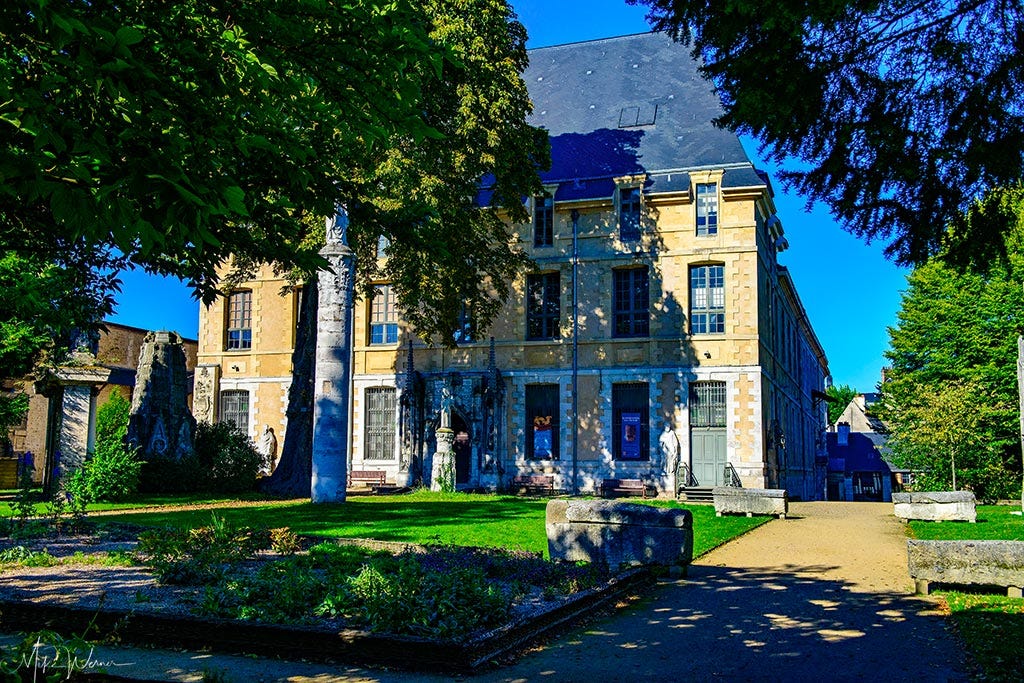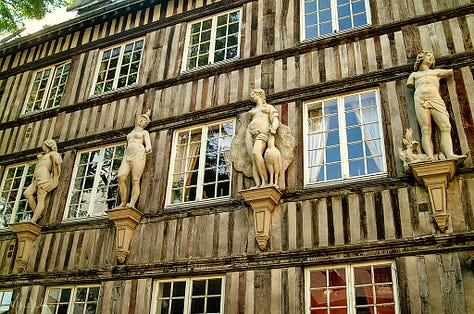
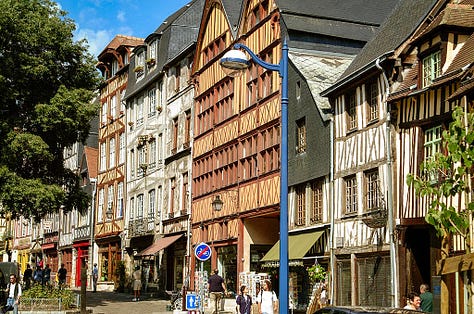
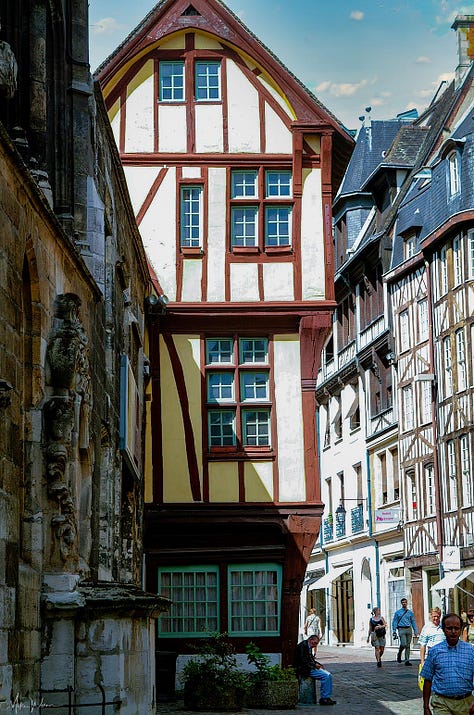
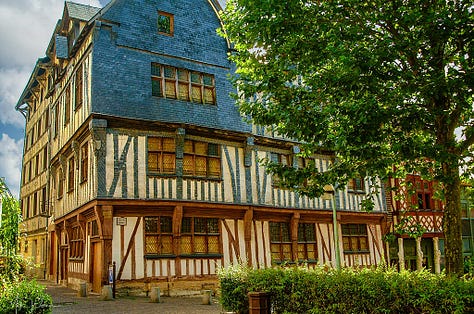


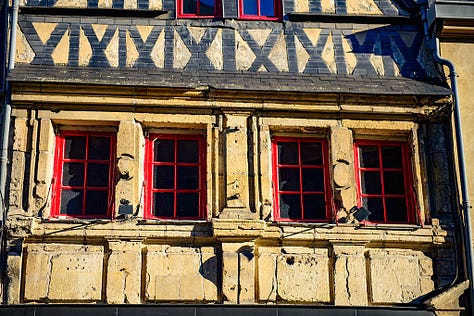
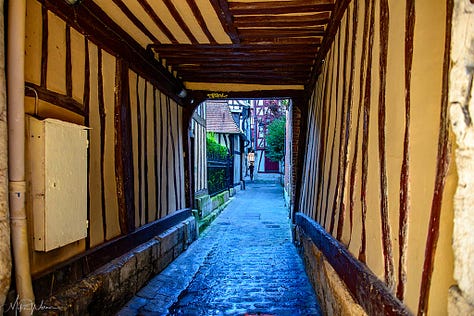
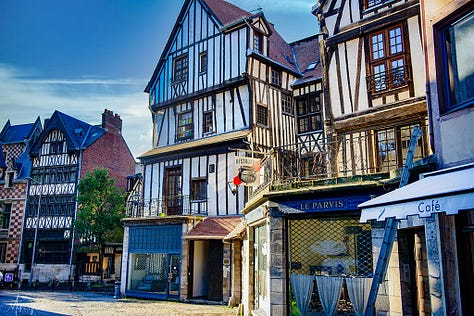
NOTE: This is Part 3 of 5 articles on the introduction of the city of Rouen. A link to the next Part will appear here when published or you can subscribe to our free newsletter and receive updates directly in your inbox.
Click here to read Part 1
Click here to read Part 2
Click here to read Part 4
Click here to read Part 5.
City Center
Rouen's historical center is a testament to its medieval past, with cobbled streets, half-timbered houses, and a range of historical buildings that give the city a distinctive character.
Gros Horloge
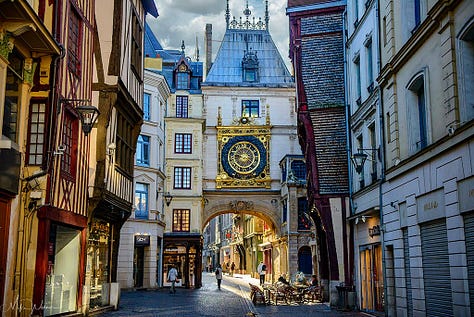
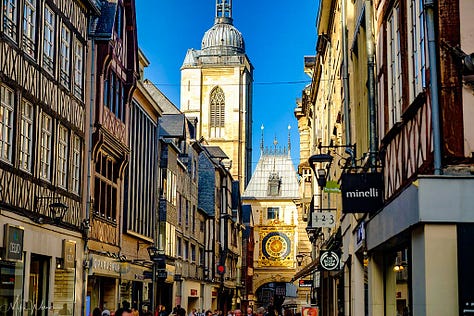
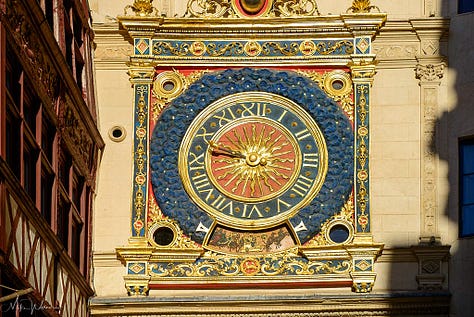
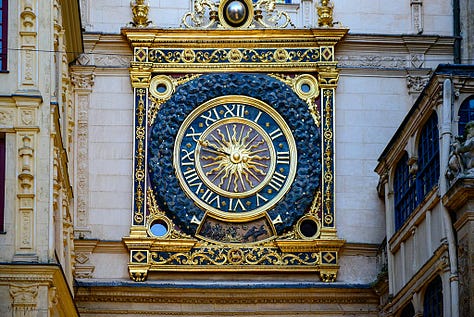
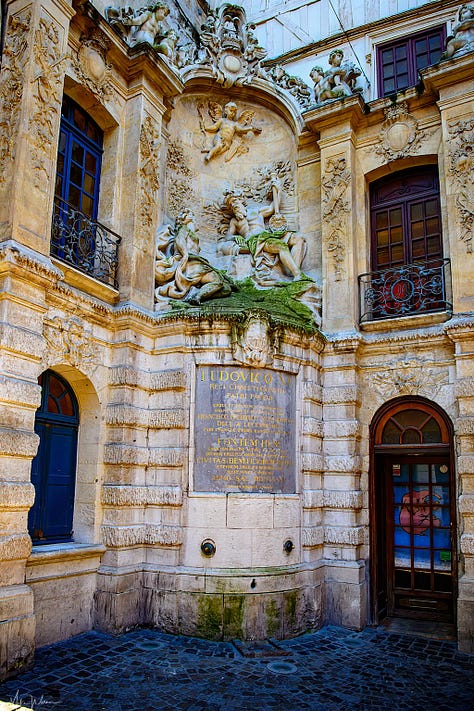
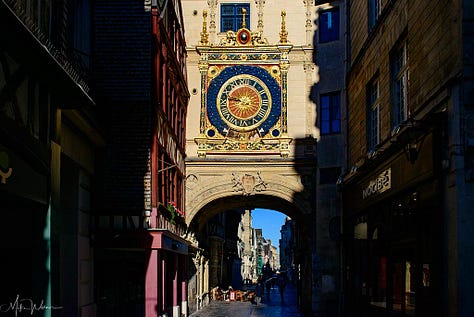
The Gros Horloge, an astronomical clock that dates back to the 14th century, is a significant feature in the cityscape. It's housed in a Renaissance arch crossing a street and is notable for its intricate mechanism and decorative dial.
This medieval clock is more than just a timepiece; it is a testament to the ingenuity and artistry of the late Middle Ages.
The Gros Horloge is situated on a Renaissance arch spanning the Rue du Gros Horloge, a bustling street in Rouen's old town. The clock itself dates back to the 14th century, making it one of the oldest working clocks in Europe. It was originally constructed in 1389, but the mechanism you see today was largely rebuilt and enhanced in the 16th century.
The clock features a single dial, composed of a 24-hour analog face that shows the phases of the moon and the days of the week, with a charming depiction of sheep and a lamb that symbolizes the wool trade, which was vital to Rouen's economy during the medieval period. This inclusion highlights not only the clock's functionality but also its role as a piece of civic pride, reflecting the prosperity and cultural significance of Rouen at the time.
The facade of the clock is adorned with a golden lamb, the heraldic symbol of the city, and it is flanked by two goddesses representing Justice and Good Governance. The ornate decorations and the sophisticated mechanism illustrate the blend of art and technology characteristic of the period.
Above the arch, there is a belfry that houses the bell and the governor's chamber. This part of the structure has also served various civic functions over the centuries, including being a lookout and a meeting place for city officials.
The Gros Horloge underwent extensive restoration in the late 1990s to preserve its artistic and mechanical integrity.
Click here to see where the Gros Horloge is located on Google Maps
Hotel de Bourgtheroulde
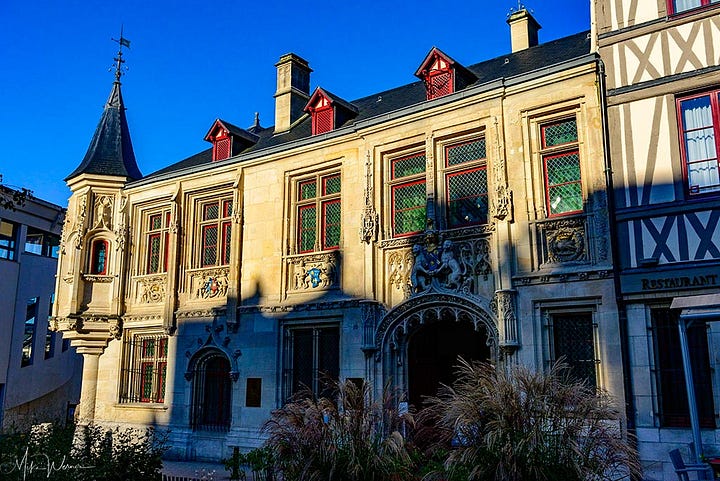
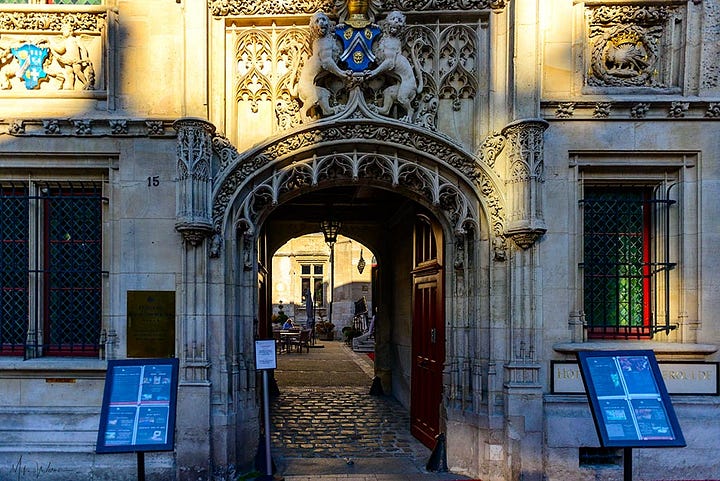
The Hôtel de Bourgtheroulde is a notable architectural gem, steeped in both history and opulence. It stands out as a prime example of Renaissance architecture in Normandy, although its origins trace back to the early 16th century when it was constructed as a private mansion for the Le Roux family. Over the centuries, this building has seen various phases of renovation and usage, each adding layers to its rich history.
The architecture of the Hôtel de Bourgtheroulde is a blend of Gothic and Renaissance styles, making it unique in the region. One of the most striking features of the building is its intricate façade, which includes sculpted reliefs depicting scenes from the "Field of the Cloth of Gold," a famous meeting between King Henry VIII of England and King Francis I of France in 1520. These reliefs are particularly valued for their historical significance and artistic merit, offering a glimpse into the pomp and circumstance of this diplomatic event.
Originally a private residence, the building has undergone numerous transformations. In the 18th century, it was converted into a bank, and over time, various other commercial uses have been made of the space. The building's historical significance was recognized in the 19th century when it was listed as a Monument Historique, France’s official list of cultural monuments.
In the 21st century, the Hôtel de Bourgtheroulde has been luxuriously restored and now operates as a boutique hotel. It features modern amenities while preserving its historical character, including the original stonework and wood paneling. The hotel includes a spa, a fine dining restaurant, and conference facilities, catering to tourists and business travelers alike.
Click here to access the hotel’s website and marvel at its design.
Click here to see where the Hôtel de Bourgtheroulde is located on Google Maps
Courts
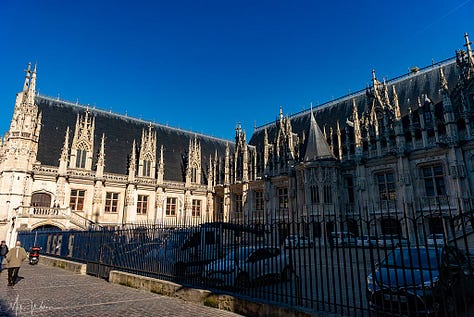
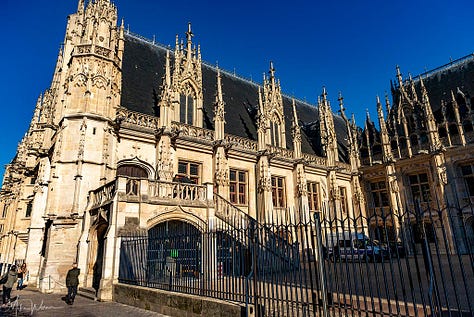
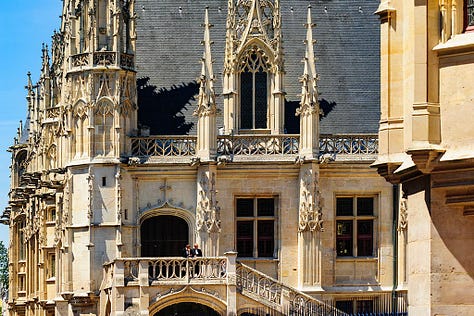
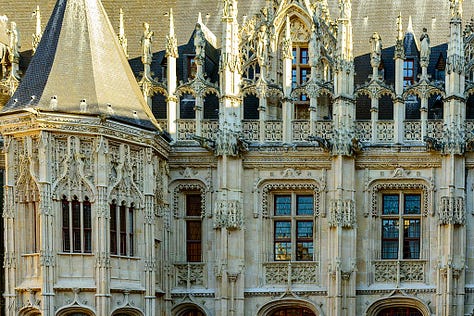
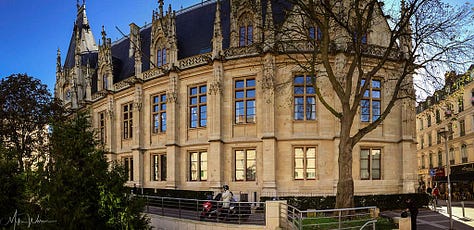
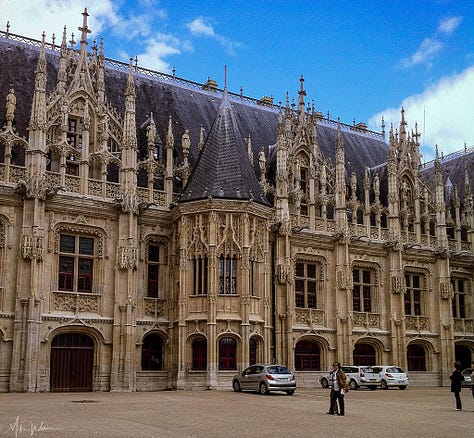
The Palais de Justice (Courts) is a striking example of Gothic architecture and holds a rich history. It was originally constructed to serve as the seat of the Parlement of Normandy, starting in the early 16th century. The building is distinguished by its flamboyant Gothic style, characterized by intricate stonework, delicate tracery, and pointed arches which are hallmarks of the period's architectural aesthetic.
The Palais de Justice has not only been a center of judicial activity but also a witness to significant historical events. During World War II, the building suffered considerable damage when it was bombed in 1944, primarily because the German army was using it as a barracks. Despite the destruction, the Palais has been meticulously restored, preserving its historical significance and architectural grandeur.
One of the most notable features of the Palais is its elaborate facade, which includes a series of gables and a beautiful rose window, typical of Gothic design. The building's roof is also noteworthy, covered in ornate lead tiles that add to its majestic appearance.
Click here to see where the courts are located on Google Maps
Museums
The city is not just about history; it's also a vibrant cultural hub. There are numerous museums:
Musee des Beaux-Arts de Rouen
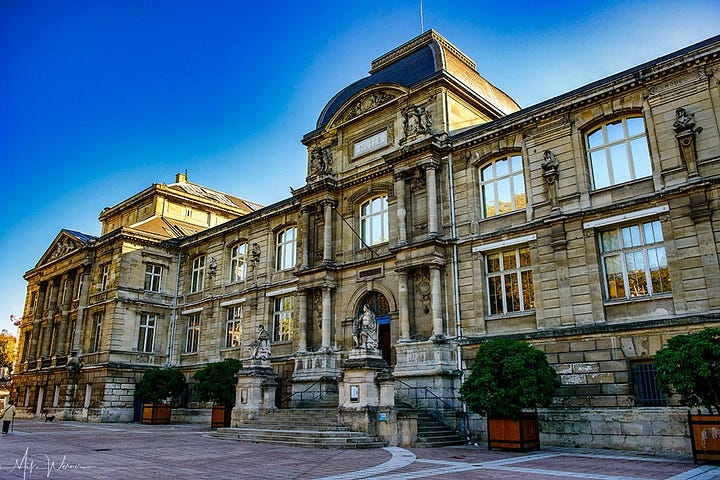
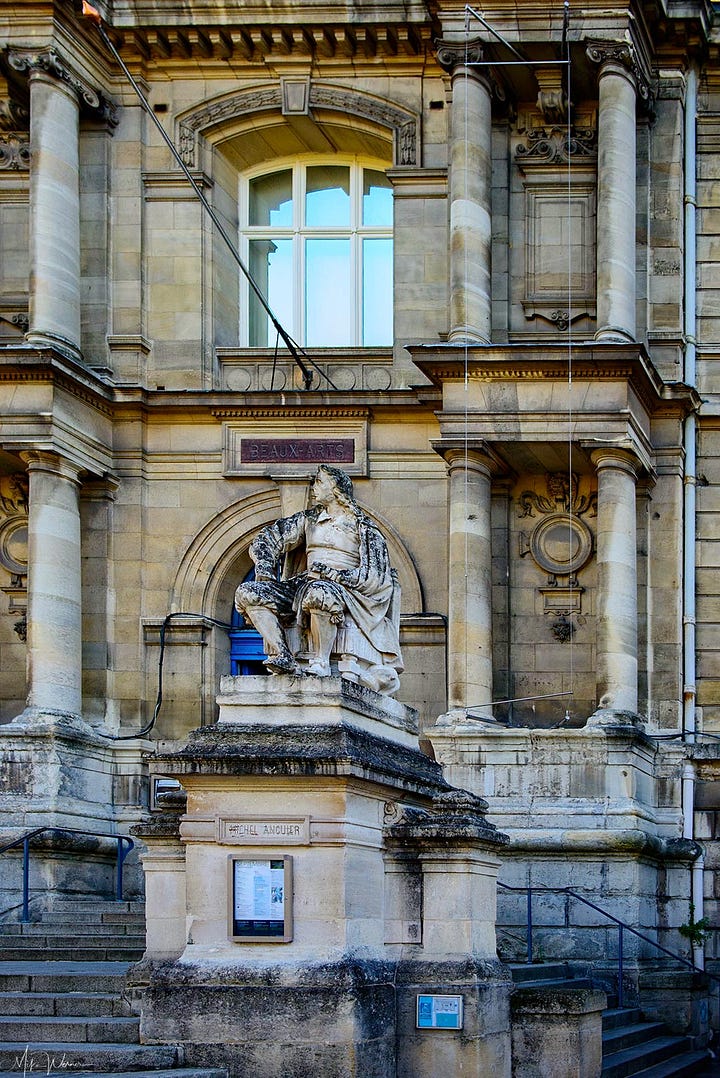
The Musée des Beaux-Arts de Rouen is one of the country's premier art galleries, renowned for its extensive collection of fine arts spanning several centuries. Established in 1801 by Napoléon Bonaparte, the museum is housed in a building that was designed and built between 1877 and 1888, offering a notable example of 19th-century architecture.
The collection at the Musée des Beaux-Arts is vast and varied, featuring paintings, sculptures, drawings, and objets d'art. It includes an impressive array of works from the Renaissance period through to the modern era. The museum is particularly famous for its rich collection of Impressionist paintings, which is one of the finest in France outside of Le Havre and Paris. This collection includes pieces by prominent artists such as Claude Monet, whose works were often inspired by the Normandy region, as well as paintings by other notable Impressionists like Camille Pissarro and Alfred Sisley.
Apart from its strong Impressionist holdings, the museum also boasts significant works from the Romantic period, the Baroque period, and the 17th-century French school. Artists such as Peter Paul Rubens, Caravaggio, and Jacques-Louis David are featured, providing visitors with a comprehensive view of European art history.
Another highlight of the museum is its collection of drawings and prints, which includes thousands of items offering insights into the artistic processes of many great European artists.
Click here to access the Museum’s website
Click here to see where the Musée des Beaux-Arts de Rouen is located on Google Maps
Musée des Antiquités de Rouen
The Musée des Antiquités de Rouen is another cultural gem. It serves as a repository of archaeological artifacts and historical relics that span a broad spectrum of time periods and cultures, offering insights into the ancient and medieval past of the region and beyond.
Established in the 19th century, the museum is housed in a former convent, the Convent of the Visitation, which itself is an architectural piece of interest with parts dating back to the 17th century. The setting adds a unique historical ambiance to the museum, enhancing the visitor's experience as they explore the collections.
The museum's collections are extensive and diverse, primarily focused on antiquities from the local area and other parts of France, but also including items from ancient Greece, Rome, and Egypt. This makes the Musée des Antiquités particularly rich in archaeological significance. Among its notable holdings are Gallo-Roman artifacts, Merovingian funeral objects, and medieval sculptures. These collections include fine examples of ceramics, coins, jewelry, tools, and everyday objects that provide a tangible connection to the past inhabitants of the region.
A standout feature of the museum is its collection of medieval artifacts, particularly those that date from the time when Rouen was a prosperous capital in the Duchy of Normandy. This includes an impressive array of stone carvings, wooden panels, and religious relics that offer a window into the medieval society and its artistic achievements.
Click here to access the museum’s website
Click here to see where the Musée des Antiquités de Rouen is located on Google Maps
Musée Le Secq des Tournelles
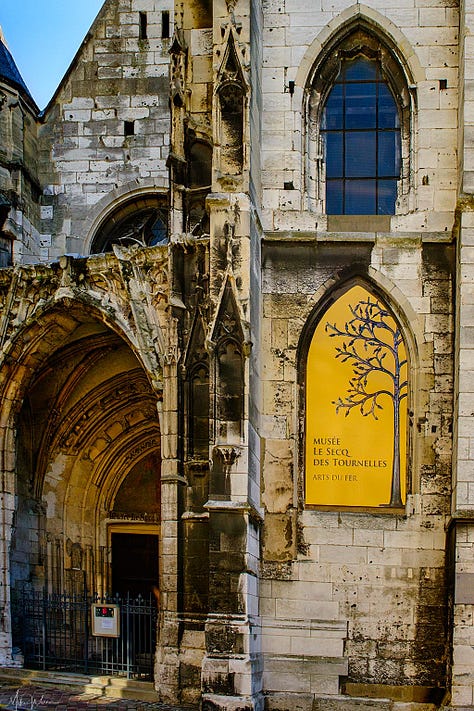
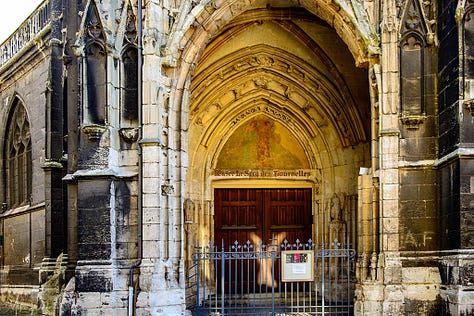
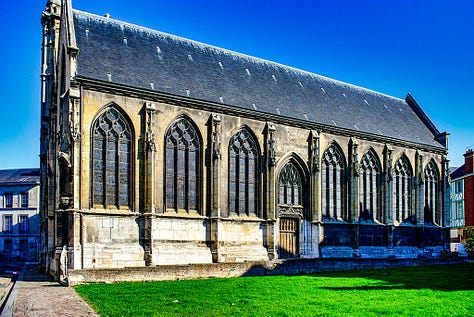
The Musée Le Secq des Tournelles is a unique museum dedicated primarily to the art and craft of metalwork. Housed in the strikingly beautiful former church of Saint-Laurent, the museum boasts a vast collection of ironwork and other metal objects that span centuries and various cultures, showcasing the skill and artistic flair of metalworkers throughout history.
The museum's building, the Church of Saint-Laurent, dates back to the 16th century and provides an atmospheric Gothic backdrop that enhances the viewing experience. The church itself was deconsecrated in the 18th century and later repurposed as a museum in the early 20th century, following the donation of the extensive collection by Henri Secq des Tournelles, a passionate collector of metal arts.
The collection includes over 14,000 items, making it one of the largest of its kind in the world. These objects range from the practical to the purely decorative, including everything from intricate locks and keys, wrought iron gates, and signs to tools, jewelry, and even surgical instruments. The diversity of the collection highlights the technical achievements and artistic creativity in working with metals like iron, steel, gold, and silver.
Among the highlights of the museum are its exquisite examples of locksmithery. This includes a variety of locks and keys, each intricately designed and crafted, some of which are functional pieces of art. The collection also includes examples of wrought ironwork that were once part of everyday life in medieval and modern Europe, such as signs, railings, and balcony grills, each piece telling its own story of the era and the hands that crafted it.
Click here to access the museum’s website
Click here to see where the Musée Le Secq des Tournelles is located on Google Maps
NOTE: This is Part 3 of 5 articles on the introduction of the city of Rouen. A link to the next Part will appear here when published or you can subscribe to our free newsletter and receive updates directly in your inbox.
Click here to read Part 1
Click here to read Part 2
Click here to read Part 4
Click here to read Part 5.




